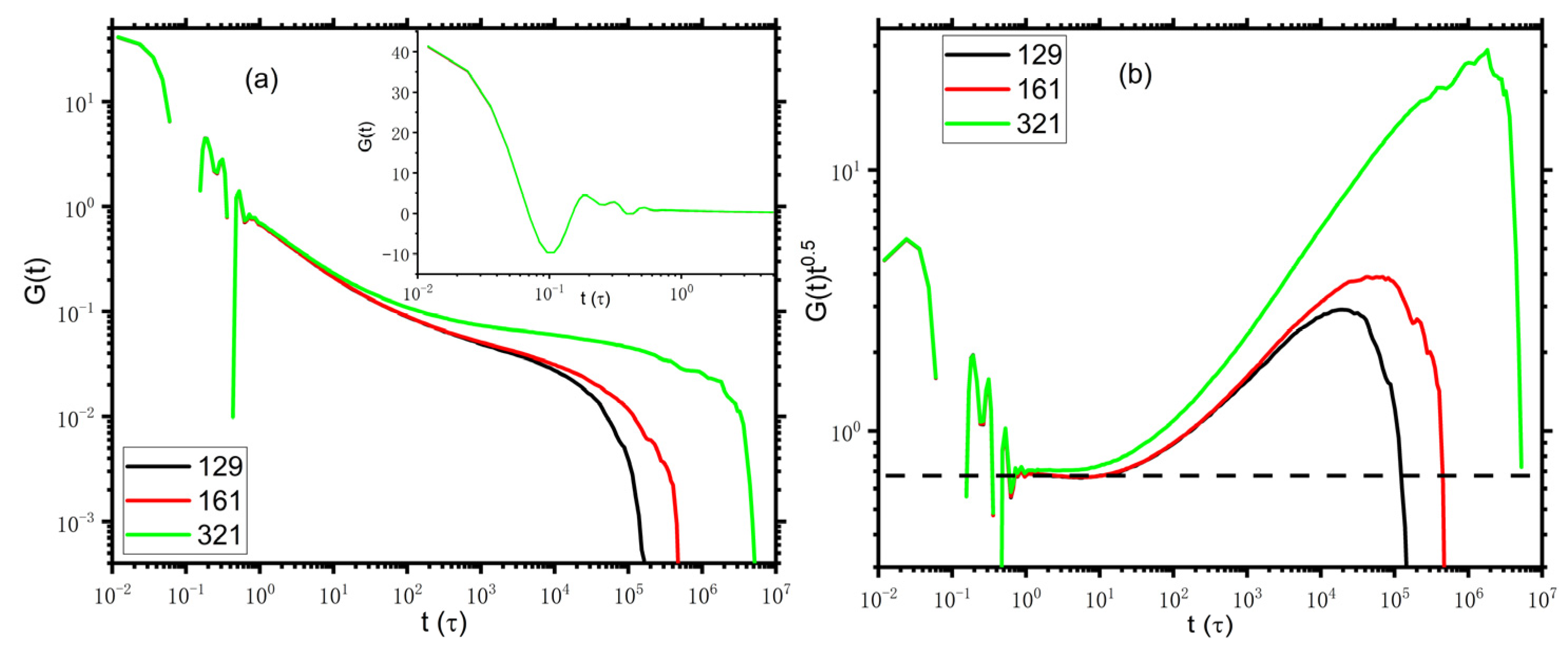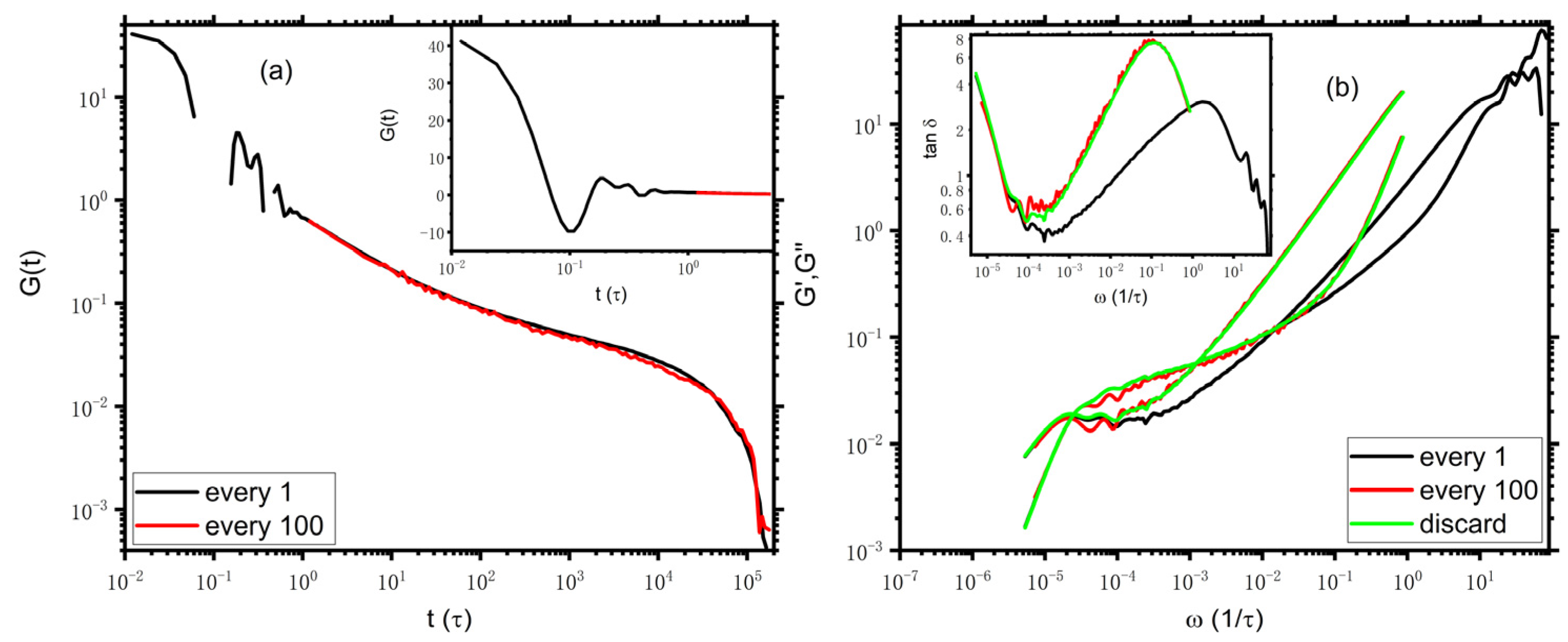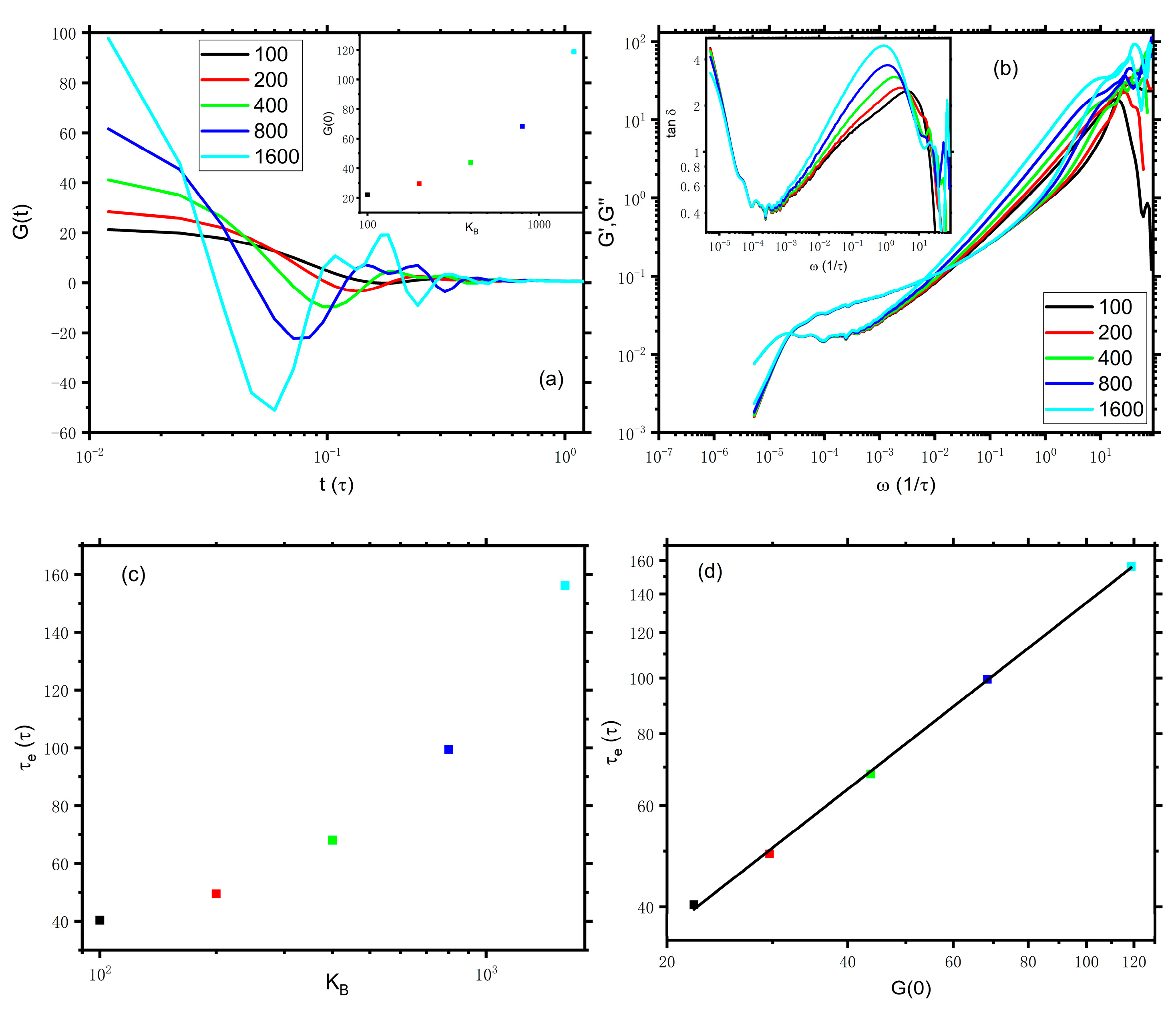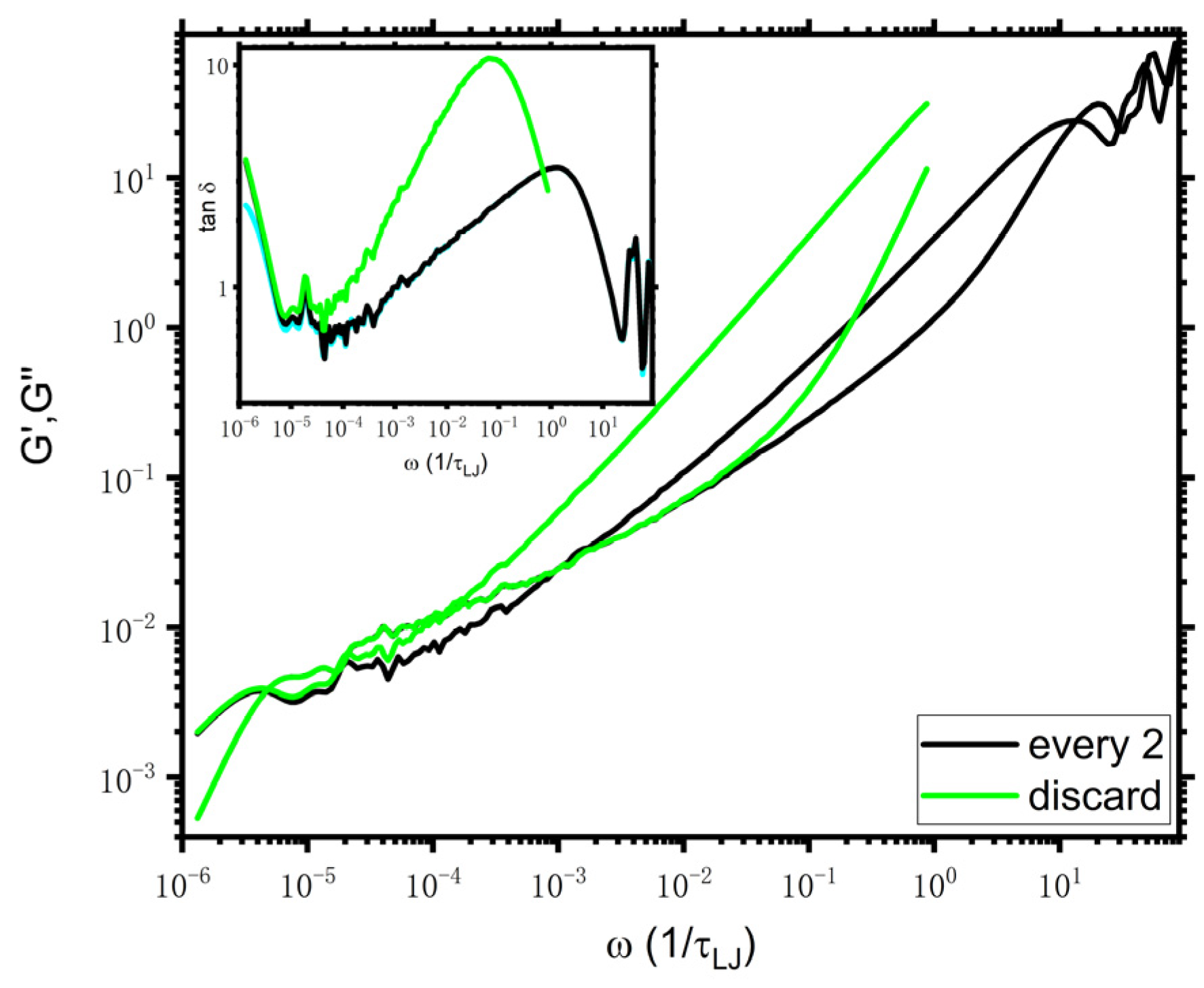3.1. DPD
We first focus on the DPD model as an alternative to the entanglement molecular model for MD simulations, which, as noted above, has become a promising tool for studying the long-time dynamics of polymeric liquids. In
Figure 1, we present the stress relaxation for the DPD polymer chains with lengths
, 161, and 321. The inset shows the bond oscillations at the early time in a semi-logarithmic plot. The stress is calculated at every timestep via the multiple-tau correlator algorithm [
1,
2]. The stress relaxation behaviors of the DPD model are qualitatively similar to those of the KG model. Note that as indicated by the horizontal dash line in
Figure 1b, the normalized stress relaxation,
, shows a plateau as expected from the Rouse model for
after the bond length relaxation. However, the slope of
for the standard KG model at
is about
, which some deviates from the prediction of the Rouse model [
1]. In this regard, the DPD model seems more suitable to describe stress relaxation.
The resulting viscoelastic moduli data via i-Rheo
GT by feeding the absolute values of
into i-Rheo
GT, as suggested in Ref. [
3], are shown in
Figure 2. Note that the quality of the curves of
are not as good as those of
and 161 since the total simulation times of the latter ones are almost 200 times longer than their disentanglement time while the simulation time of the former one is less than a decade of its disentanglement time. Nevertheless,
Figure 2 distinctly indicates a crossover point of the storage elastic modulus
and the loss of viscous modulus
at
in the intermediate frequency scale for all systems. Furthermore, as presented in the inset of
Figure 2,
, which is in agreement with the theory and experiments [
3]. We could further estimate
from
where the subscript
in
indicates the entanglement time is obtained from i-Rheo
GT.
are about 68, 67, and 44 for
, 161, and 321, respectively, much smaller (beyond an order of magnitude) than the entanglement time estimated from MSD, which is indicated as
or
given in
Figure S1 in SI. This finding is similar to the results of KG and PE models reported by Tassieri et al. [
3], as mentioned above. Additionally, the smaller value
of
than those of the other two shorter counterparts indicates that
relies on the chain length, as further evidenced by the broad chain length window in
Figure S2 in SI, which qualitatively agrees with the results of PE by Tassieri et al. [
3] as well.
Experimentally, the highest sampling frequency of the rheometers is limited in the mega-hertz range and is usually quite smaller than that taken in molecular simulations, wherein the stress is often sampled every timestep, and the corresponding sampling frequency is in the tera-hertz range [
3,
14]. Therefore, it is interesting to check the effects of the limited dynamic window as accessed by experiment instruments on the Fourier transformation of
via i-Rheo
GT. We now discard the short time data of
, corresponding to the regime of the bond length relaxation, during the transformation from
to
and
just as early works in experiments and simulations. [
1,
9] We note that for the DPD model used here, the bond length relaxation regime would be “naturally” discarded if the stress is calculated every hundred timesteps since the corresponding sampling time interval is
, with
being the simulation timestep and
being DPD time unit, which is larger than the relaxation time of the bond oscillations, i.e., about
as indicated by the inset of
Figure 1. Taking
as an example, as demonstrated in
Figure 3a, the resulting
curves from stress data calculated every timestep and every hundred timesteps (denoted as “every 1” and “every 100”, respectively) fall practically on top of each other, though
of “every 100” is with poorer quality. As an alternative route to discarding the high-frequency domain of bond length relaxation, we can “artificially” discard the
data at an early time, i.e.,
, while stress and the original
are calculated at every timestep, which is denoted as “discard” in what follows. As expected, in
Figure 3b, the viscoelastic spectrums from
of “every 100” nearly overlap with those of “discard”. Since the moduli of “discard” are of better quality than the moduli of “every 100”, for a better understanding of the limited dynamic window problem, we would focus on comparisons of the moduli of “every 1” and “discard” later. As indicated by the black and green lines, though the
curves of “every 1” and “discard” lie on top of each other for
,
of the former is smaller than that of the latter apart from
at the terminal scale, which
is in the same magnitude as both “every 1” and “discard”. Consequently, the cross point of the moduli of “discard” moves to a lower frequency regime. Interestingly, the resulting
is about 820, which is approximately an order of magnitude larger than that estimated from the moduli of “every 1” but very close to
estimated from MSD, as mentioned above. In this regard, the result of discarding the early bond oscillation regime appears to be more consistent with results from other common physical observables, independent of the “naturally” or “artificially” discarding approach used. As we see below, this also holds true for both KG and PE models. A consistent result could be anticipated when i-Rheo
GT is used to analyze the experimental data since the time scale corresponding to the bond length relaxation is hardly accessible and is usually not included in the rheological experiments. Additionally, as demonstrated by the black and red lines in
Figure 3, it seems very tricky that for i-Rheo
GT, the sampling time interval plays a critical role in the determination of
, even though the time interval is still smaller than
by tens of times. We note that the time scale corresponding to the bond length relaxation is beyond the consideration of tube theory on the viscoelastic properties of the polymers [
15], while in real polymer melts, there exists an intricate interplay between bonded and non-bonded interactions. The method of i-Rheo
GT to process the data of the coupling interactions between the different dynamics mechanisms at different time regimes might be the origin of the observed deviation. This, to some extent, is qualitatively similar to the case in which single-chain models obey the stress-optical law rather well for times longer than the bond length relaxation time, whereas for many-chain models, it is valid on slightly longer time scales as a consequence of complicated coupling of the interactions. [
23] Nevertheless, we note that as shown in the inset, for the moduli discarding the bond oscillation regime,
which disagrees with the theoretical and experimental expectation.
The results discussed above show whether the inclusion of the bond length relaxation regime or not plays an important role in the exact determination of relevant parameters in rheology via i-Rheo
GT. To gain a detailed insight into the influences of the bond length relaxation regime on the determination of
we do further analysis on the “discard” data. For simplicity, we tune the spring constant,
, of bonded beads and artificially replace the data of
by the ones from DPD simulations with different spring constants while the data of
remain unchanged. Note that a smaller
would result in the crossability of chains and a larger
requires a smaller timestep [
22]. Here, the stress is calculated at every time of
though the timestep is different for different
. Taking
as an example again, the early oscillations of bond relaxation for different spring constants, which range from 100 to 1600, are presented in
Figure 4a. The height and number of peaks increase with the increase of the spring constant, indicating that the oscillations become more intense and complicated. Particularly, the value of
increases quickly with the spring constant, as demonstrated in the inset of
Figure 4a.
Figure 4b presents the corresponding viscoelastic moduli. Although the
curves of different spring constants lie on top of each other,
generally increase with the increase in the spring constant for
. The different responses of
and
to the spring constant are similar to the responses of
and
to the sampling frequency as mentioned above. Hence, the values of
for the cross point become smaller with the increase in the spring constant. The resulting
depends strongly on the spring constant
as presented in
Figure 4c, even though
are the same for all systems with different spring constants. Additionally, we would like to point out that
even shows an exponential dependence on
, which can be described by a power law of
as demonstrated in
Figure 4d. These findings convincingly demonstrate that the dynamics at the shorter time scale could intensively affect the calculation of
located at a longer (at least by dozens of times) scale when applying i-Rheo
GT to convert
into
and
, while the same
is expected to be obtained if we “artificially” discard the data of
. Altogether, our DPD results reveal the limits of applicability of i-Rheo
GT to the exact determination of relevant parameters in rheology. The reason for this apparent failure lies in the method of i-Rheo
GT to process the data of the coupling interactions between the different dynamic mechanisms at different time regimes.
3.2. KG
To elucidate the above issues further, we consider KG model as another test case and check the consistency of
estimated from i-Rheo
GT with those available reference data from other methods. The chain length is
which is the same as the longest chain of Tassieri et al. [
3] Note that the stress is calculated every two timesteps here to keep the same sampling time interval with the work of Tassieri et al. [
3] since the sampling frequency seems to play a role in i-Rheo
GT analysis as mentioned above. The resulting viscoelastic moduli of the KG model are shown in
Figure 5. The curves of “every 2” are generally the same as those in the work of Tassieri et al. [
3] despite that the quality of the curves at the middle scale (
) in this work is poorer. An approximate range of
estimated from
(as shown in the inset of
Figure 5) is
, which is comparable with the result of 671 reported by Tassieri et al. [
3] but is quite smaller than those calculated by other methods as mentioned above. Additionally, the characteristic time for
is about 25, which is smaller than
by several tens of times. Consequently, the expectation of
is not satisfied from the results of “every 2” for the KG model (this expectation is met for the DPD model). Like in the DPD case, we “artificially” discard the
data at an early time, i.e.,
. As indicated by the green curves in
Figure 5, the behaviors of
and
are similar to those of the DPD model described above, namely, the curve of
of “discard” falls on top of that of “every 2” and
is on the top of that of “every 2”, except for the terminal scale.
estimated from
of “discard” is
, which is comparable with the values from other estimators as mentioned above, i.e.,
estimated from MSD for the KG model is
[
24], thus
. Nevertheless, the expectation of
is not satisfied from the results of “discard” as well.
3.3. PE
For a complete understanding of the limits of applicability of i-Rheo
GT, we then consider the well-studied atomistic PE model. The MD simulation condition is the same as the work of Tassieri et al. [
3] (at 450 K, 1 atm). The stress is calculated at every timestep
. The molecular weight is 5.04 kg/mol, corresponding to
carbon atoms per chain.
Figure 6 presents the viscoelastic moduli of PE. Similar to the results of DPD and KG models, the curves of
of “every 1” and “discard” lie on top of each other as
while the curves of
of these two cases overlap with each other only at the terminal regime.
are approximately estimated to be 0.55 ns and 4.2 ns from “every 1” and “discard”, respectively. Note that these two
are separately compared with the value calculated from i-Rheo
GT (which is 0.37 ns for the molecular weight being 5.04 kg/mol) and the value of ~5.5 ns estimated from MSD in Ref. [
3]. Consistent with DPD and KG models,
estimated from “discard” here is in better agreement with
from other methods, however,
from “every 1” appears to be somewhat smaller. As for
, the values are about 2.1 for “every 1”and 4.4 for “discard”, which is similar to the case of DPD.
To further elaborate on the influence of the high-frequency dynamics, we gradually discard the data from the highest range and the obtained
is presented in
Figure 7. For
ns, the obtained
remains unchanged and is quite smaller than the reported values shown by the lines and symbols on the left-hand side. The obtained
increases quickly with the increase of
before the end of bond length relaxation (
) and increases even faster after the bond length relaxation. Note that the experimentally accessible time range is quite larger than the relaxation time of bond length fluctuation (~
ns). Generally, the resulting
from i-Rheo
GT would be comparable with the reported ones, which are obtained from MSD, rheology theory mapping, neutron spin-echo spectroscopy (NSE), and rheology experiments if the high-frequency dynamics is discarded, indicating that the ability to interpret the data at the high-frequency dynamics for i-Rheo
GT seems insufficient in the current framework of the tube theory. It would be very interesting to look forward to improving rheology theory and experiment techniques to interpret high-frequency dynamics.













